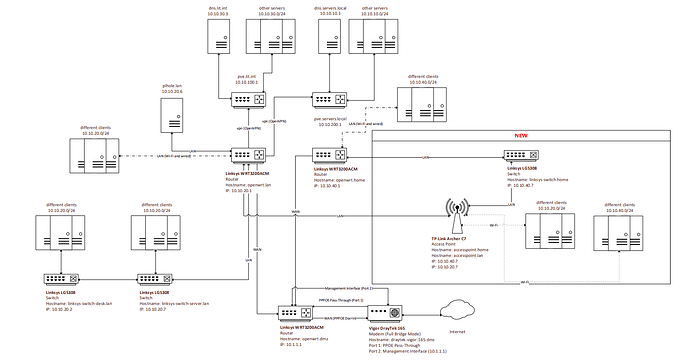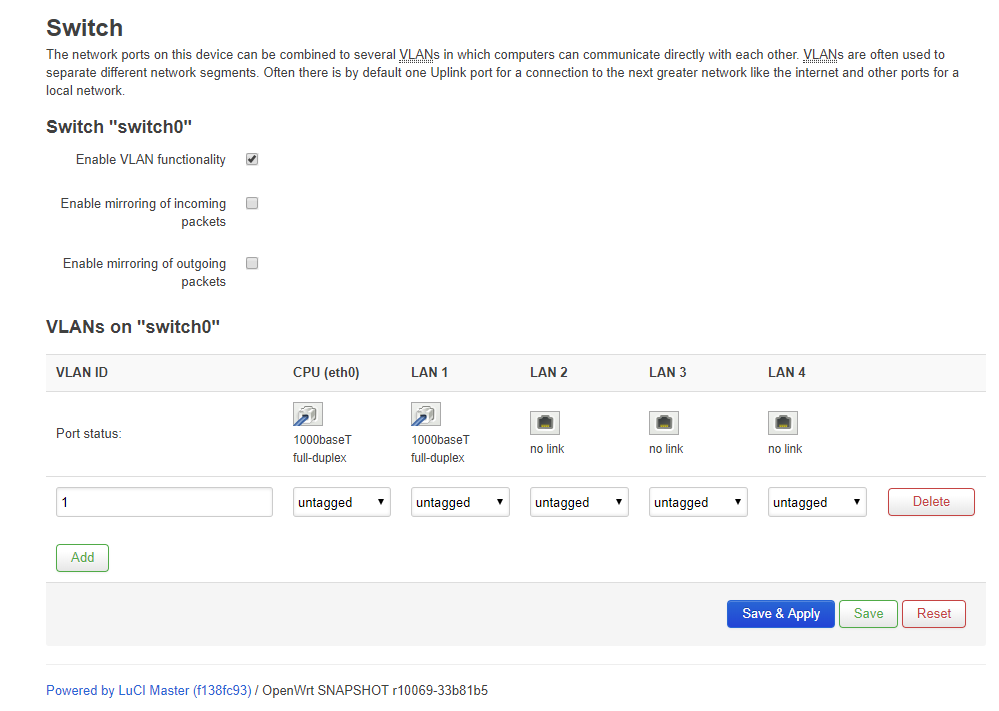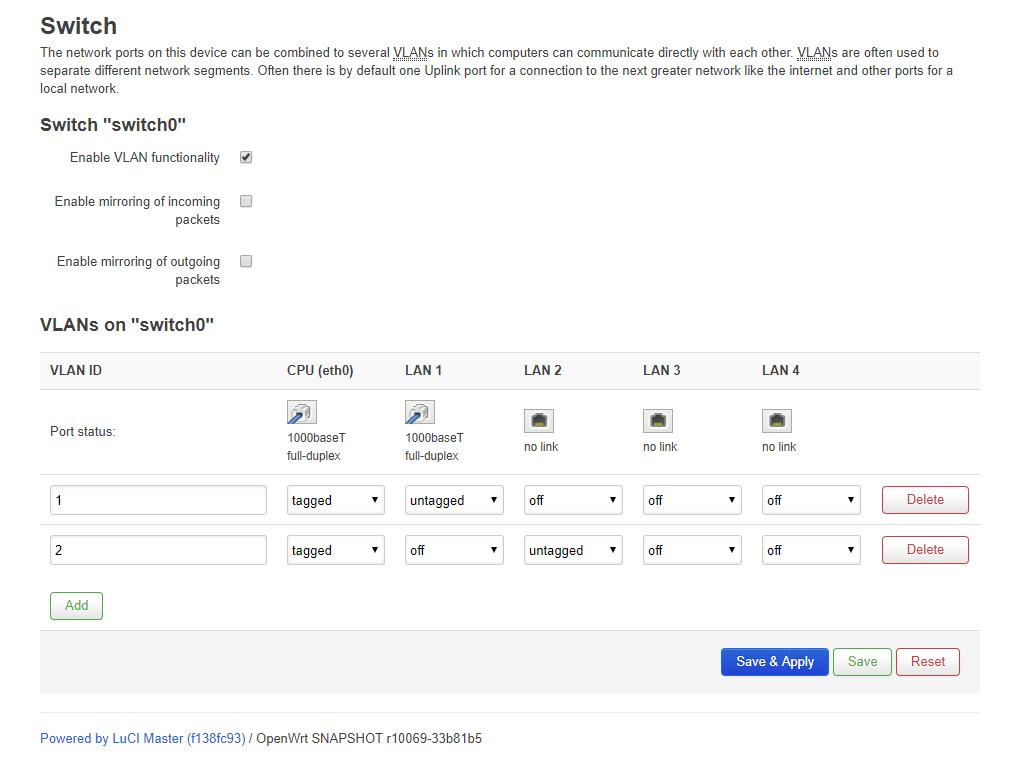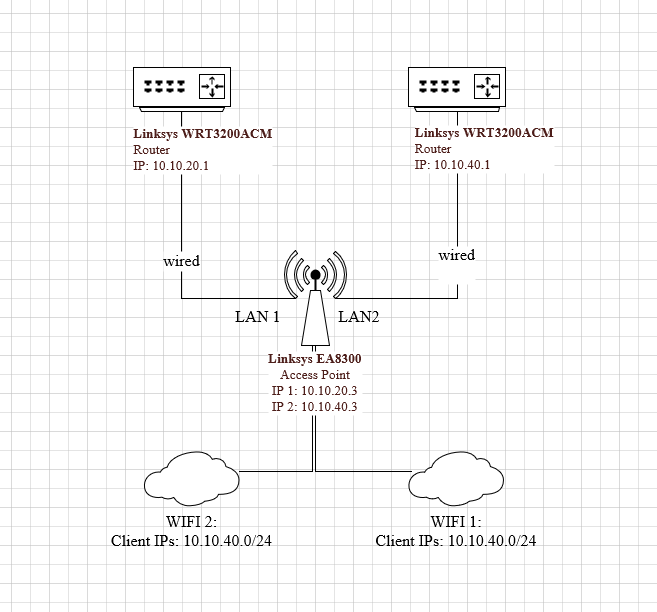Thank you very much!!
I got it working just like you said (untagged) - this is good enough for me at the moment. Looking forward for your fix however! 
Nevertheless, I think I ran into another issue with the Wi-Fi devices (specifically with the 3rd band, which serves only channels starting from 100) - sometimes it seems like the SSID is not getting broadcasted (LuCi says "Wireless is not associated" for that SSID, although it is) and I cannot find it using any wireless device (tested with a Google Pixel 2 XL and a Lenovo ThinkPad [2018 model, forgot the exact naming, sorry]).
I have a feeling it is somehow associated to "DFS" - although I have just a really basic understanding of that topic, but I thought I'd point it out and you (or someone else) gets a clue through that.
I tried a lot of different settings, but apparently it is not associated to my total number of SSIDs (I have 4), as I am able to create all of them on the other 5GHz (2 of them here) and the 2,4GHz (2 of them here) bands.
I have checked via iw list, but as far as I understand the output, I am able to bring up 16 SSIDs per band - so far more than I need.
Here is the output of it:
root@OpenWrt:~# iw list
Wiphy phy2
max # scan SSIDs: 16
max scan IEs length: 199 bytes
max # sched scan SSIDs: 0
max # match sets: 0
max # scan plans: 1
max scan plan interval: -1
max scan plan iterations: 0
Retry short limit: 7
Retry long limit: 4
Coverage class: 0 (up to 0m)
Device supports AP-side u-APSD.
Available Antennas: TX 0x3 RX 0x3
Configured Antennas: TX 0x3 RX 0x3
Supported interface modes:
* IBSS
* managed
* AP
* monitor
* mesh point
* P2P-client
* P2P-GO
* P2P-device
Band 2:
Capabilities: 0x19ef
RX LDPC
HT20/HT40
SM Power Save disabled
RX HT20 SGI
RX HT40 SGI
TX STBC
RX STBC 1-stream
Max AMSDU length: 7935 bytes
DSSS/CCK HT40
Maximum RX AMPDU length 65535 bytes (exponent: 0x003)
Minimum RX AMPDU time spacing: 8 usec (0x06)
HT TX/RX MCS rate indexes supported: 0-15
VHT Capabilities (0x339959b2):
Max MPDU length: 11454
Supported Channel Width: neither 160 nor 80+80
RX LDPC
short GI (80 MHz)
TX STBC
SU Beamformer
SU Beamformee
MU Beamformer
MU Beamformee
RX antenna pattern consistency
TX antenna pattern consistency
VHT RX MCS set:
1 streams: MCS 0-9
2 streams: MCS 0-9
3 streams: not supported
4 streams: not supported
5 streams: not supported
6 streams: not supported
7 streams: not supported
8 streams: not supported
VHT RX highest supported: 0 Mbps
VHT TX MCS set:
1 streams: MCS 0-9
2 streams: MCS 0-9
3 streams: not supported
4 streams: not supported
5 streams: not supported
6 streams: not supported
7 streams: not supported
8 streams: not supported
VHT TX highest supported: 0 Mbps
Frequencies:
* 5180 MHz [36] (20.0 dBm)
* 5200 MHz [40] (20.0 dBm)
* 5220 MHz [44] (20.0 dBm)
* 5240 MHz [48] (20.0 dBm)
* 5260 MHz [52] (20.0 dBm) (radar detection)
* 5280 MHz [56] (20.0 dBm) (radar detection)
* 5300 MHz [60] (20.0 dBm) (radar detection)
* 5320 MHz [64] (20.0 dBm) (radar detection)
* 5500 MHz [100] (disabled)
* 5520 MHz [104] (disabled)
* 5540 MHz [108] (disabled)
* 5560 MHz [112] (disabled)
* 5580 MHz [116] (disabled)
* 5600 MHz [120] (disabled)
* 5620 MHz [124] (disabled)
* 5640 MHz [128] (disabled)
* 5660 MHz [132] (disabled)
* 5680 MHz [136] (disabled)
* 5700 MHz [140] (disabled)
* 5720 MHz [144] (disabled)
* 5745 MHz [149] (disabled)
* 5765 MHz [153] (disabled)
* 5785 MHz [157] (disabled)
* 5805 MHz [161] (disabled)
* 5825 MHz [165] (disabled)
* 5845 MHz [169] (disabled)
* 5865 MHz [173] (disabled)
valid interface combinations:
* #{ managed } <= 16, #{ AP, mesh point } <= 16, #{ IBSS } <= 1,
total <= 16, #channels <= 1, STA/AP BI must match, radar detect widths: { 20 MHz (no HT), 20 MHz, 40 MHz, 80 MHz }
HT Capability overrides:
* MCS: ff ff ff ff ff ff ff ff ff ff
* maximum A-MSDU length
* supported channel width
* short GI for 40 MHz
* max A-MPDU length exponent
* min MPDU start spacing
Supported extended features:
* [ VHT_IBSS ]: VHT-IBSS
* [ RRM ]: RRM
* [ SET_SCAN_DWELL ]: scan dwell setting
* [ CQM_RSSI_LIST ]: multiple CQM_RSSI_THOLD records
* [ CONTROL_PORT_OVER_NL80211 ]: control port over nl80211
* [ TXQS ]: FQ-CoDel-enabled intermediate TXQs
Wiphy phy1
max # scan SSIDs: 16
max scan IEs length: 195 bytes
max # sched scan SSIDs: 0
max # match sets: 0
max # scan plans: 1
max scan plan interval: -1
max scan plan iterations: 0
Retry short limit: 7
Retry long limit: 4
Coverage class: 0 (up to 0m)
Device supports AP-side u-APSD.
Available Antennas: TX 0x3 RX 0x3
Configured Antennas: TX 0x3 RX 0x3
Supported interface modes:
* IBSS
* managed
* AP
* monitor
* mesh point
* P2P-client
* P2P-GO
* P2P-device
Band 1:
Capabilities: 0x19ef
RX LDPC
HT20/HT40
SM Power Save disabled
RX HT20 SGI
RX HT40 SGI
TX STBC
RX STBC 1-stream
Max AMSDU length: 7935 bytes
DSSS/CCK HT40
Maximum RX AMPDU length 65535 bytes (exponent: 0x003)
Minimum RX AMPDU time spacing: 8 usec (0x06)
HT TX/RX MCS rate indexes supported: 0-15
VHT Capabilities (0x339959b2):
Max MPDU length: 11454
Supported Channel Width: neither 160 nor 80+80
RX LDPC
short GI (80 MHz)
TX STBC
SU Beamformer
SU Beamformee
MU Beamformer
MU Beamformee
RX antenna pattern consistency
TX antenna pattern consistency
VHT RX MCS set:
1 streams: MCS 0-9
2 streams: MCS 0-9
3 streams: not supported
4 streams: not supported
5 streams: not supported
6 streams: not supported
7 streams: not supported
8 streams: not supported
VHT RX highest supported: 0 Mbps
VHT TX MCS set:
1 streams: MCS 0-9
2 streams: MCS 0-9
3 streams: not supported
4 streams: not supported
5 streams: not supported
6 streams: not supported
7 streams: not supported
8 streams: not supported
VHT TX highest supported: 0 Mbps
Frequencies:
* 2412 MHz [1] (20.0 dBm)
* 2417 MHz [2] (20.0 dBm)
* 2422 MHz [3] (20.0 dBm)
* 2427 MHz [4] (20.0 dBm)
* 2432 MHz [5] (20.0 dBm)
* 2437 MHz [6] (20.0 dBm)
* 2442 MHz [7] (20.0 dBm)
* 2447 MHz [8] (20.0 dBm)
* 2452 MHz [9] (20.0 dBm)
* 2457 MHz [10] (20.0 dBm)
* 2462 MHz [11] (20.0 dBm)
* 2467 MHz [12] (20.0 dBm)
* 2472 MHz [13] (20.0 dBm)
* 2484 MHz [14] (disabled)
valid interface combinations:
* #{ managed } <= 16, #{ AP, mesh point } <= 16, #{ IBSS } <= 1,
total <= 16, #channels <= 1, STA/AP BI must match, radar detect widths: { 20 MHz (no HT), 20 MHz, 40 MHz, 80 MHz }
HT Capability overrides:
* MCS: ff ff ff ff ff ff ff ff ff ff
* maximum A-MSDU length
* supported channel width
* short GI for 40 MHz
* max A-MPDU length exponent
* min MPDU start spacing
Supported extended features:
* [ VHT_IBSS ]: VHT-IBSS
* [ RRM ]: RRM
* [ SET_SCAN_DWELL ]: scan dwell setting
* [ CQM_RSSI_LIST ]: multiple CQM_RSSI_THOLD records
* [ CONTROL_PORT_OVER_NL80211 ]: control port over nl80211
* [ TXQS ]: FQ-CoDel-enabled intermediate TXQs
Wiphy phy0
max # scan SSIDs: 16
max scan IEs length: 199 bytes
max # sched scan SSIDs: 0
max # match sets: 0
max # scan plans: 1
max scan plan interval: -1
max scan plan iterations: 0
Retry short limit: 7
Retry long limit: 4
Coverage class: 0 (up to 0m)
Device supports AP-side u-APSD.
Device supports T-DLS.
Available Antennas: TX 0x3 RX 0x3
Configured Antennas: TX 0x3 RX 0x3
Supported interface modes:
* IBSS
* managed
* AP
* monitor
* mesh point
* P2P-client
* P2P-GO
* P2P-device
Band 2:
Capabilities: 0x19ef
RX LDPC
HT20/HT40
SM Power Save disabled
RX HT20 SGI
RX HT40 SGI
TX STBC
RX STBC 1-stream
Max AMSDU length: 7935 bytes
DSSS/CCK HT40
Maximum RX AMPDU length 65535 bytes (exponent: 0x003)
Minimum RX AMPDU time spacing: 8 usec (0x06)
HT TX/RX MCS rate indexes supported: 0-15
VHT Capabilities (0x339979b2):
Max MPDU length: 11454
Supported Channel Width: neither 160 nor 80+80
RX LDPC
short GI (80 MHz)
TX STBC
SU Beamformer
SU Beamformee
MU Beamformer
MU Beamformee
RX antenna pattern consistency
TX antenna pattern consistency
VHT RX MCS set:
1 streams: MCS 0-9
2 streams: MCS 0-9
3 streams: not supported
4 streams: not supported
5 streams: not supported
6 streams: not supported
7 streams: not supported
8 streams: not supported
VHT RX highest supported: 0 Mbps
VHT TX MCS set:
1 streams: MCS 0-9
2 streams: MCS 0-9
3 streams: not supported
4 streams: not supported
5 streams: not supported
6 streams: not supported
7 streams: not supported
8 streams: not supported
VHT TX highest supported: 0 Mbps
Frequencies:
* 5180 MHz [36] (disabled)
* 5200 MHz [40] (disabled)
* 5220 MHz [44] (disabled)
* 5240 MHz [48] (disabled)
* 5260 MHz [52] (disabled)
* 5280 MHz [56] (disabled)
* 5300 MHz [60] (disabled)
* 5320 MHz [64] (disabled)
* 5500 MHz [100] (26.0 dBm) (radar detection)
* 5520 MHz [104] (26.0 dBm) (radar detection)
* 5540 MHz [108] (26.0 dBm) (radar detection)
* 5560 MHz [112] (26.0 dBm) (radar detection)
* 5580 MHz [116] (26.0 dBm) (radar detection)
* 5600 MHz [120] (26.0 dBm) (radar detection)
* 5620 MHz [124] (26.0 dBm) (radar detection)
* 5640 MHz [128] (26.0 dBm) (radar detection)
* 5660 MHz [132] (26.0 dBm) (radar detection)
* 5680 MHz [136] (26.0 dBm) (radar detection)
* 5700 MHz [140] (26.0 dBm) (radar detection)
* 5720 MHz [144] (disabled)
* 5745 MHz [149] (13.0 dBm)
* 5765 MHz [153] (13.0 dBm)
* 5785 MHz [157] (13.0 dBm)
* 5805 MHz [161] (13.0 dBm)
* 5825 MHz [165] (13.0 dBm)
* 5845 MHz [169] (disabled)
* 5865 MHz [173] (disabled)
valid interface combinations:
* #{ managed } <= 16, #{ AP, mesh point } <= 16, #{ IBSS } <= 1,
total <= 16, #channels <= 1, STA/AP BI must match, radar detect widths: { 20 MHz (no HT), 20 MHz, 40 MHz, 80 MHz }
HT Capability overrides:
* MCS: ff ff ff ff ff ff ff ff ff ff
* maximum A-MSDU length
* supported channel width
* short GI for 40 MHz
* max A-MPDU length exponent
* min MPDU start spacing
Supported extended features:
* [ VHT_IBSS ]: VHT-IBSS
* [ RRM ]: RRM
* [ SET_SCAN_DWELL ]: scan dwell setting
* [ CQM_RSSI_LIST ]: multiple CQM_RSSI_THOLD records
* [ CONTROL_PORT_OVER_NL80211 ]: control port over nl80211
* [ TXQS ]: FQ-CoDel-enabled intermediate TXQs
root@OpenWrt:~#
Also following the output of /etc/config/network:
root@OpenWrt:~# cat /etc/config/network
config interface 'loopback'
option ifname 'lo'
option proto 'static'
option ipaddr '127.0.0.1'
option netmask '255.0.0.0'
config globals 'globals'
option ula_prefix 'fda0:6d9e:9136::/48'
config interface 'home'
option type 'bridge'
option ifname 'eth0'
option proto 'dhcp'
option ip6assign '60'
option delegate '0'
config interface 'office'
option type 'bridge'
option ifname 'eth1'
option proto 'dhcp'
option ip6assign '60'
config switch
option name 'switch0'
option reset '1'
option enable_vlan '1'
config switch_vlan
option device 'switch0'
option vlan '1'
option ports '1 2 3 4 0'
root@OpenWrt:~#
And the output of /etc/config/wireless (with the current non-working settings for band3 (channel >= 100):
root@OpenWrt:~# cat /etc/config/wireless
config wifi-device 'radio0'
option type 'mac80211'
option hwmode '11a'
option path 'soc/40000000.pci/pci0000:00/0000:00:00.0/0000:01:00.0'
option htmode 'VHT80'
option country 'DE'
option channel 'auto'
option legacy_rates '0'
config wifi-device 'radio1'
option type 'mac80211'
option hwmode '11g'
option path 'platform/soc/a000000.wifi'
option htmode 'HT20'
option legacy_rates '1'
option country 'DE'
option txpower '20'
option channel '6'
config wifi-device 'radio2'
option type 'mac80211'
option hwmode '11a'
option path 'platform/soc/a800000.wifi'
option htmode 'VHT80'
option legacy_rates '1'
option txpower '20'
option channel '36'
option country 'DE'
config wifi-iface
option device 'radio1'
option mode 'ap'
option ssid 'Toadette'
option encryption 'psk2'
option key 'REMOVED'
option network 'office'
config wifi-iface
option device 'radio2'
option mode 'ap'
option network 'home'
option encryption 'psk2'
option key 'REMOVED'
option ssid 'Yoshi'
config wifi-iface
option device 'radio1'
option mode 'ap'
option ssid 'Kirby'
option network 'home'
option encryption 'psk2'
option key 'REMOVED'
config wifi-iface
option device 'radio0'
option mode 'ap'
option ssid 'Peach'
option network 'office'
option encryption 'psk2'
option key 'REMOVED'
config wifi-iface
option device 'radio2'
option mode 'ap'
option ssid 'Peach'
option network 'office'
option encryption 'psk2'
option key 'REMOVED'
Please note, I added the second SSID Peach twice (for testing purposes only). I am only interested in bringing Peach up on the "3rd band".
BTW: Should I open another thread for this issue, or can we discuss it here?
Thank you very much!
Small note:
The EA8300 has definitely better Wi-Fi than my WRT3200ACMs (range wise), with still reasonable throughput (~300MBit on the 5GHz band) on mid range (~10-15m with two walls across) - I am super happy with that.






